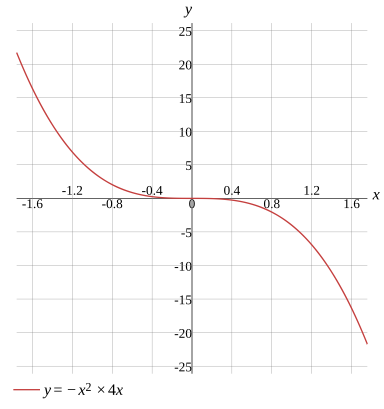Question
Function
Find the inverse
Evaluate the derivative
Find the domain
Load more

f−1(x)=−232x
Evaluate
y=−x2×4x
Simplify
More Steps


Evaluate
−x2×4x
Multiply
More Steps


Evaluate
x2×4x
Multiply the terms with the same base by adding their exponents
x2+1×4
Add the numbers
x3×4
Use the commutative property to reorder the terms
4x3
−4x3
y=−4x3
Interchange x and y
x=−4y3
Swap the sides of the equation
−4y3=x
Change the signs on both sides of the equation
4y3=−x
Divide both sides
44y3=4−x
Divide the numbers
y3=4−x
Use b−a=−ba=−ba to rewrite the fraction
y3=−4x
Take the 3-th root on both sides of the equation
3y3=3−4x
Calculate
y=3−4x
Simplify the root
More Steps


Evaluate
3−4x
To take a root of a fraction,take the root of the numerator and denominator separately
343−x
Multiply by the Conjugate
34×3423−x×342
Calculate
223−x×342
Calculate
More Steps


Evaluate
3−x×342
The product of roots with the same index is equal to the root of the product
3−x×42
Calculate the product
3−42x
An odd root of a negative radicand is always a negative
−342x
Simplify the radical expression
−232x
22−232x
Divide the terms
More Steps


Evaluate
22−2
Use the product rule aman=an−m to simplify the expression
22−1−1
Subtract the terms
21−1
Simplify
2−1
Use b−a=−ba=−ba to rewrite the fraction
−21
2−32x
Calculate
−232x
y=−232x
Solution
f−1(x)=−232x
Show Solution

Testing for symmetry
Testing for symmetry about the origin
Testing for symmetry about the x-axis
Testing for symmetry about the y-axis
Symmetry with respect to the origin
Evaluate
y=−x24x
Simplify the expression
y=−4x3
To test if the graph of y=−4x3 is symmetry with respect to the origin,substitute -x for x and -y for y
−y=−4(−x)3
Simplify
More Steps


Evaluate
−4(−x)3
Rewrite the expression
−4(−x3)
Multiply the numbers
4x3
−y=4x3
Change the signs both sides
y=−4x3
Solution
Symmetry with respect to the origin
Show Solution

Solve the equation
Solve for x
Solve for y
x=−232y
Evaluate
y=−x2×4x
Simplify
More Steps


Evaluate
−x2×4x
Multiply
More Steps


Evaluate
x2×4x
Multiply the terms with the same base by adding their exponents
x2+1×4
Add the numbers
x3×4
Use the commutative property to reorder the terms
4x3
−4x3
y=−4x3
Swap the sides of the equation
−4x3=y
Change the signs on both sides of the equation
4x3=−y
Divide both sides
44x3=4−y
Divide the numbers
x3=4−y
Use b−a=−ba=−ba to rewrite the fraction
x3=−4y
Take the 3-th root on both sides of the equation
3x3=3−4y
Calculate
x=3−4y
Solution
More Steps


Evaluate
3−4y
To take a root of a fraction,take the root of the numerator and denominator separately
343−y
Multiply by the Conjugate
34×3423−y×342
Calculate
223−y×342
Calculate
More Steps


Evaluate
3−y×342
The product of roots with the same index is equal to the root of the product
3−y×42
Calculate the product
3−42y
An odd root of a negative radicand is always a negative
−342y
Simplify the radical expression
−232y
22−232y
Divide the terms
More Steps


Evaluate
22−2
Use the product rule aman=an−m to simplify the expression
22−1−1
Subtract the terms
21−1
Simplify
2−1
Use b−a=−ba=−ba to rewrite the fraction
−21
2−32y
Calculate
−232y
x=−232y
Show Solution

Rewrite the equation
r=0r=−4cos3(θ)sin(θ)r=−−4cos3(θ)sin(θ)
Evaluate
y=−x2×4x
Simplify
More Steps


Evaluate
−x2×4x
Multiply
More Steps


Evaluate
x2×4x
Multiply the terms with the same base by adding their exponents
x2+1×4
Add the numbers
x3×4
Use the commutative property to reorder the terms
4x3
−4x3
y=−4x3
Move the expression to the left side
y+4x3=0
To convert the equation to polar coordinates,substitute x for rcos(θ) and y for rsin(θ)
sin(θ)×r+4(cos(θ)×r)3=0
Factor the expression
4cos3(θ)×r3+sin(θ)×r=0
Factor the expression
r(4cos3(θ)×r2+sin(θ))=0
When the product of factors equals 0,at least one factor is 0
r=04cos3(θ)×r2+sin(θ)=0
Solution
More Steps


Factor the expression
4cos3(θ)×r2+sin(θ)=0
Subtract the terms
4cos3(θ)×r2+sin(θ)−sin(θ)=0−sin(θ)
Evaluate
4cos3(θ)×r2=−sin(θ)
Divide the terms
r2=−4cos3(θ)sin(θ)
Evaluate the power
r=±−4cos3(θ)sin(θ)
Separate into possible cases
r=−4cos3(θ)sin(θ)r=−−4cos3(θ)sin(θ)
r=0r=−4cos3(θ)sin(θ)r=−−4cos3(θ)sin(θ)
Show Solution

Graph
